Last updated: January 16, 2025
Article
Smallpox, Inoculation, and the Revolutionary War
During the 1700s, smallpox raged through the American colonies and the Continental Army. Smallpox impacted the Continental Army severely during the Revolutionary War, so much so that George Washington mandated inoculation for all Continental soldiers in 1777. Just fifty-six years earlier, in 1721, Bostonian doctors and clergy introduced the procedure to the American colonies. Without the vision and determination of these early Bostonians in normalizing inoculation, Washington may not have made the decision to mandate inoculation for the Continental Army. Though it was a controversial action, many historians credit the medical mandate with the colonists’ victory in the Revolutionary War and the creation of the United States of America.
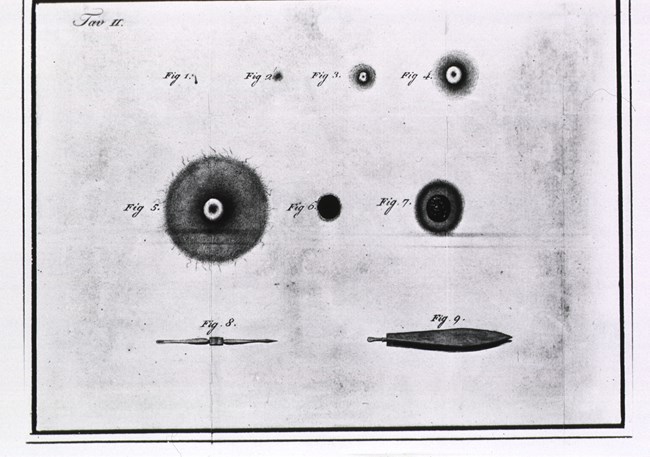
"[Smallpox: Instruments for inoculation and developing pustule]," National Library of Medicine
What is smallpox?
Throughout history, disease outbreaks sparked fear for many. Before the invention of vaccinations in 1796, people had very few ways to protect themselves from disease. Without the advancements of modern medicine, many contracted illnesses proved fatal. Among the deadliest and most widespread diseases was smallpox, caused by the microscopic variola virus. Symptoms of smallpox include fever, nausea, vomiting, body aches, and the characteristic pustules or pox. Smallpox likely originated in northeastern Africa around 10,000 B.C.E., though the exact location and time frame is uncertain. The disease later spread to Asia and Europe. When Spanish and Portuguese conquistadors arrived in the Americas, they brought smallpox with them, which devastated the Indigenous populations of South and Central America. During the French and Indian War, British forces used smallpox as a biological weapon to weaken the Indigenous tribes that assisted the French.[1]
With every smallpox outbreak, people observed that those who had survived the infection typically did not get smallpox again. For those who contracted smallpox a second time, the infection was much less severe and usually not fatal. These observations led to the creation of inoculation, the process of contracting smallpox on purpose to induce immunity and reduce the risk of death. Smallpox inoculation was a simple procedure: a doctor removed pus from an active pustule of an infected person, and then inserted that pus into the skin of a non-infected person via a small incision. The insertion of the pus resulted in the inoculated person contracting smallpox. Despite being infected, the inoculated person usually experienced only mild symptoms that were not life threatening. Inoculation had been practiced for centuries in parts of Asia and northeastern Africa before being introduced to Europe, and eventually the North American colonies.[2]
Smallpox, both the naturally contracted disease and the inoculated version, were common in the crowded cities of Europe. Most Europeans did not make it through childhood without contracting the disease, and those who survived became immune. Doctors inoculated those who did not contract the disease naturally. Not only was most of Europe immune to smallpox, but most of the British military was as well. During this era, most American colonists lived in the countryside far from their neighbors, which reduced smallpox transmission. Because few American colonists had contracted the disease before, the colonies experienced sporadic and deadly outbreaks of smallpox. There was never a widespread epidemic that resulted in herd immunity.[3]
Boston and Smallpox
Colonial Boston had faced many smallpox outbreaks throughout the 1700s, the most severe of which occurred in 1721, 1752, 1764, and 1775. During the 1721 outbreak in Boston, Reverend Cotton Mather, an influential Puritan minister and notable participant in the Salem Witch Trials, learned of the process of inoculation from Onesimus, a Western African whom Mather enslaved. Mather convinced Dr. Zabdiel Boylston, a Boston medical doctor, to begin inoculations in Boston to prevent further spread of the disease.[4]
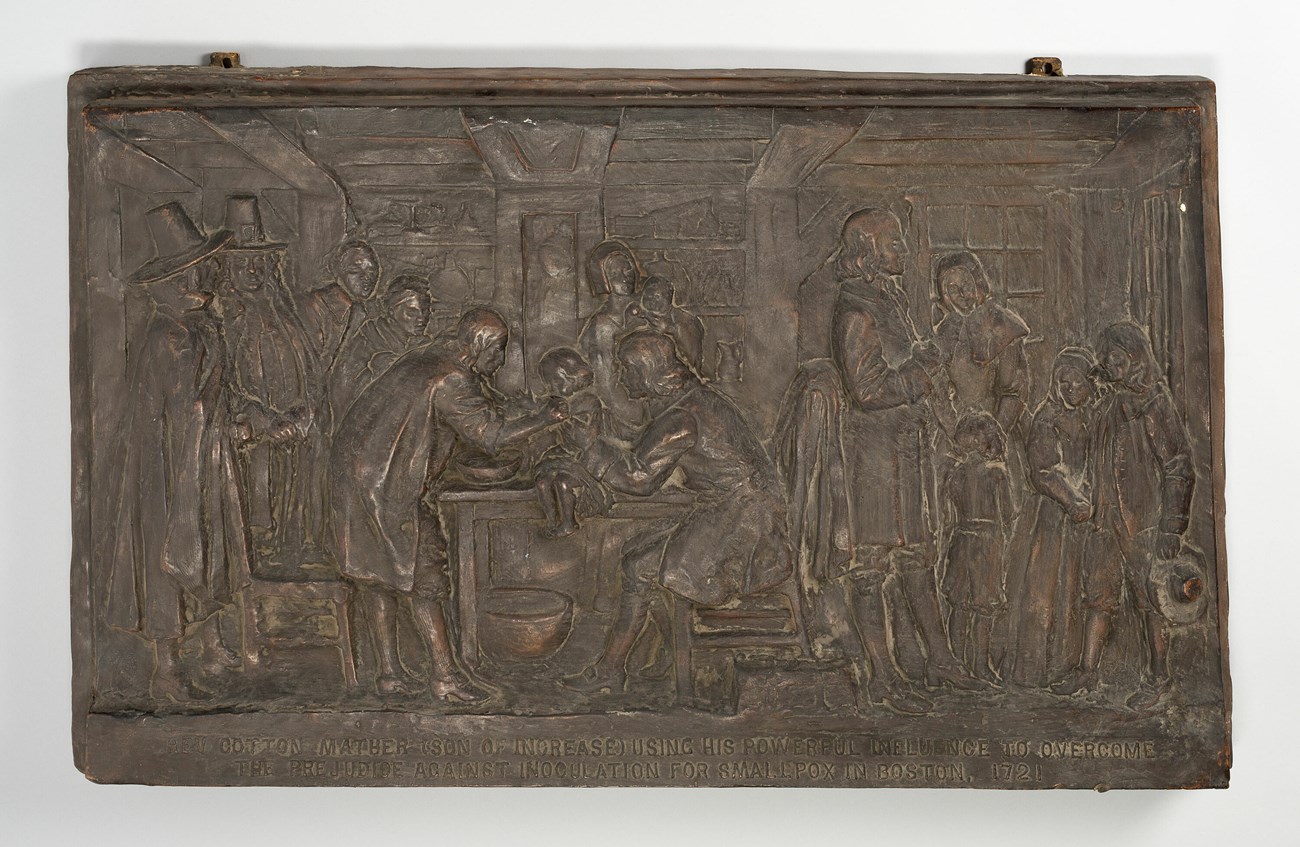
"Rev. Cotton Mather (Son of Increase) Using His Powerful Influence to Overcome the Prejudice Against Inoculation for Smallpox in Boston, 1721." Sally James Farnham, c. 1915, Courtesy of the Art Institute of Chicago.
Despite being widely accepted in Europe, inoculation became incredibly controversial in Boston. Many people believed the procedure was more deadly than naturally contracting smallpox, even though evidence suggested otherwise. Also, the clergy claimed that smallpox was God's punishment for sin. They argued that inoculating against smallpox interfered with God's will. Boston newspapers published arguments for and against inoculation, polarizing Bostonians on the subject. The inoculations became so controversial that at one point, an angry citizen threw a bomb at Mather's house to try to intimidate Mather and Boylston from continuing inoculations.[5]
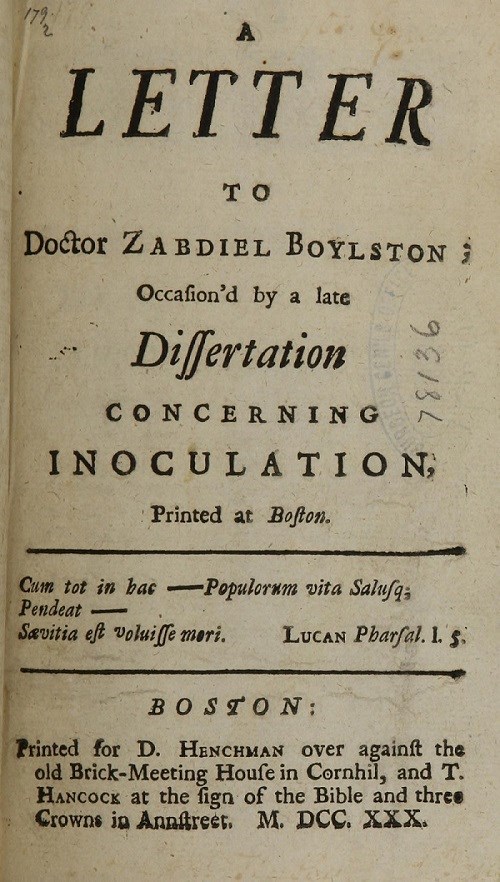
"A letter to Doctor Zabdiel Boylston : occasion'd by a late Dissertation concerning inoculation, printed at Boston." by Daniel Henchman, 1730; U.S. National Library of Medicine, Archive.org.
Regardless of some Bostonians' reservations, Boylston continued the inoculation procedures and studied previous outbreaks. To prove the safety of inoculations, Boylston compared outbreaks to demonstrate that inoculations were relatively safe. Boylston noted that during the epidemic of 1721, the estimated fatality rate of those who naturally contracted smallpox was 14%, while the fatality rate of the inoculated was only 2%. Though many Bostonians feared and distrusted the procedure initially, in subsequent outbreaks inoculation was slowly accepted.[6]
Smallpox greatly affected many people in Boston, including prominent figures of the colonial Boston community. During the 1764 outbreak, one of Paul Revere's children was infected with the disease. This forced the family to quarantine in their North End home until the child recovered.[7] During the 1760s, Dr. Joseph Warren operated a smallpox inoculation clinic on Castle Island in Boston Harbor. In 1764, Warren inoculated John Adams, the future second President of the United States.[8] In fact, Warren inoculated much of Boston against smallpox, until his death at the Battle of Bunker Hill in 1775. Later, in 1776, Abigail Adams inoculated herself and her children against the disease. In a letter to her husband John, Abigail recounts the experience and the atmosphere around inoculations in Boston: "Such a Spirit of inoculation [sic] never before took place; the Town and every House in it, are as full as they can hold....God Grant that we may all go comfortably thro [sic] the Distemper."[9]
Smallpox and the Revolution
Despite the progressive acceptance of inoculation throughout the colonies, another smallpox outbreak seized Boston in 1775. After the Battle of Bunker Hill in June of 1775, military actions between the British, led by General William Howe, and the colonists, led by George Washington, stalled. Smallpox was gripping the citizens of Boston, and to some extent Howe's troops. Washington knew that the Continental soldiers, many from rural, isolated parts of the colonies and therefore not immune to smallpox, would be devastated by an outbreak. The stalemate between Washington and Howe continued until March 7, 1776, when General Howe announced that the British army planned to evacuate Boston. Despite this victory for the colonists, Washington initially forbade his troops from entering the city because of the smallpox epidemic. On March 17, Washington permitted one thousand men who had previously contracted smallpox to enter the city. Washington could discern who previously had the disease from the pox scars on the faces of survivors.[10]
Smallpox and the Canadian Campaign
As the Revolutionary War progressed, smallpox continued to affect military operations. In 1775, Continental soldiers, led by Colonel Benedict Arnold, marched from Cambridge, Massachusetts towards Quebec to prevent the city from falling to the British. Just one month later, in December, smallpox was reported among the soldiers. Smallpox crippled the forces in Canada, preventing them from launching an attack on Quebec in late 1775. Many soldiers’ scheduled enlistment ended on January 1, 1776 and a majority warned their superiors they planned to not reenlist due to fear of the disease. These soldiers would rather desert the cause than risk death by smallpox.
These soon-to-be expired enlistments forced Arnold and General Richard Montgomery to launch their assault on Quebec before the year's end. Montgomery later reported that only about 800 men were able to fight, as the rest were sick with smallpox. The lack of healthy soldiers resulted in a spectacular failed attack on Quebec on December 30. British forces killed Montgomery, wounded Arnold, and captured hundreds of colonists. Arnold maintained substantial forces around Quebec in hopes of launching a second, successful assault, however, the lack of reinforcements and the ravages of smallpox impeded any future attack.[11]
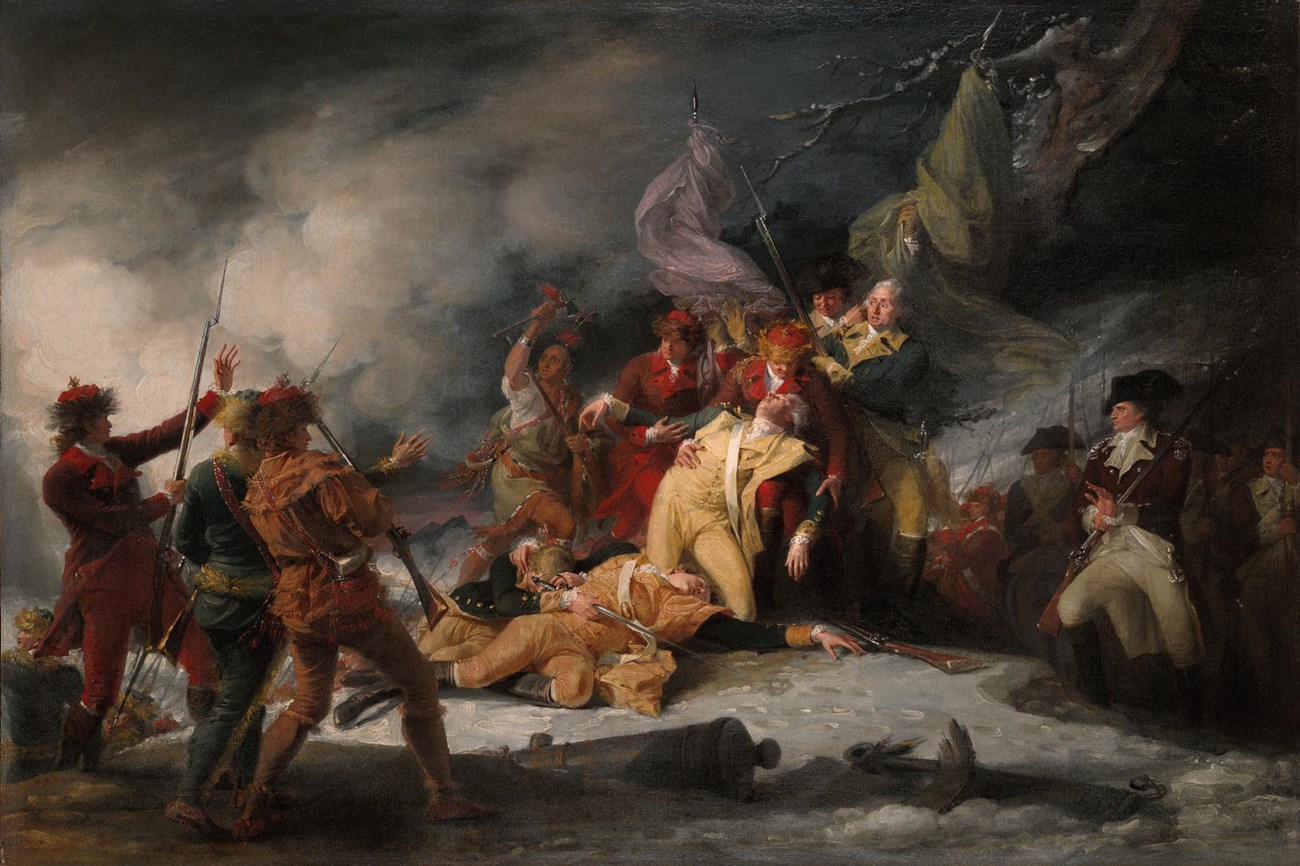
John Trumbull, Yale University Art Gallery
Fear of smallpox grew among the ranks in the northern division of the Continental Army. Wanting to protect themselves from the disease, soldiers began inoculating themselves with smallpox, without the guidance of a doctor. These soldiers ignored a crucial component in the process of inoculation: quarantine. Due to this mistake, smallpox spread rapidly in the Army. As infection rates rose, more soldiers self-inoculated out of fear, spreading the disease to even more men. In February of 1776, Arnold forbade the practice of inoculation by penalty of death to prevent rampant spread. However, fear of the disease was so great among soldiers, they inoculated themselves in secret anyways. According to historian Charles Cushing, "the soldiers were willing to run any hazard rather than take [smallpox] the natural way."[12]
In March of 1776, Major General John Thomas, a medical doctor and military commander, arrived to take control of the Continental forces in Canada. The Continental Congress hoped Thomas could provide the necessary expertise to turn the tide of the Continental Army's Canadian campaign. Though Arnold later changed his mind on the inoculation ban, Thomas refused to allow inoculations. He feared that the Continental soldiers would not have enough time to recuperate from the inoculated disease in case of British attack. However, he did organize the creation of a smallpox hospital in Montreal to prevent further spread of the disease among the soldiers. Since Thomas had never had the disease and therefore lacked immunity, congressional staffers recommended he get inoculated out of fear of losing an experienced commander. Thomas, however, refused inoculation in solidarity with the soldiers for whom he had just forbidden the practice. By refusing inoculation Thomas signed his own death warrant, as he contracted the disease after arriving in Canada and died shortly thereafter.[13]
In the absence of General Thomas, the Continental forces in Canada did not have a strong leader.[14] From Philadelphia, John Adams wrote to his wife Abigail, who remained at their home in Braintree: "Our misfortunes in Canada are enough to melt a heart of stone. The small-pox is ten times more terrible than Britons, Canadians, and Indians together. This was the cause of our precipitate retreat from Quebeck [sic]; this is the cause of our disgraces at the Cedars."[15] It was apparent that smallpox, rather than British might or Continental Army inadequacy, was the reason for the Army’s defeat in Canada.[16]
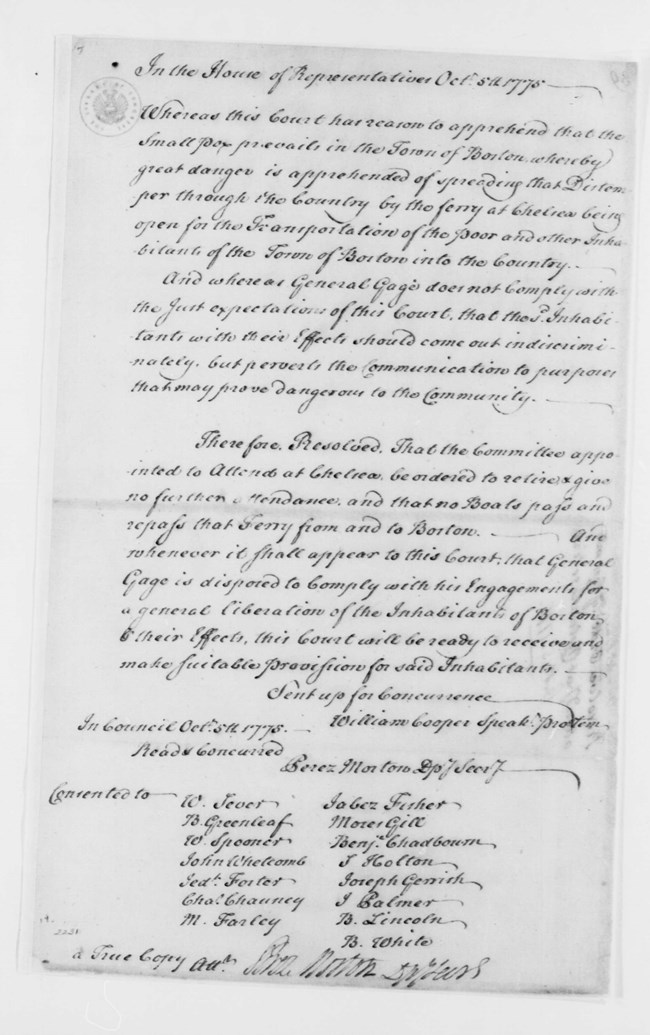
"Massachusetts House of Representatives, October 5, 1775, Smallpox Resolution," George Washington Papers, Series 4, General Correspondence, Library of Congress.
General Washington and Smallpox
Washington understood the grave threat smallpox imposed upon the Continental Army and their chances of winning the war. He even described smallpox as "more destructive than the sword."[17] However, Washington also feared the spread of smallpox between soldiers who did not quarantine after inoculating. Washington wrote "when I recall to mind the unhappy situation of our Northern Army last year I shudder at the consequence of this disorder if some vigorous steps are not taken to stop spreading it."[18] In a letter to Dr. William Shippen Jr., director of the medical department of the Continental Army, Washington proclaimed:
Finding the smallpox to be spreading much and fearing that no precaution can prevent it from running thro’ the whole of our Army, I have determined that the Troops shall be inoculated. This Expedient may be attended with some inconveniences and some disadvantages, but yet I trust, in its consequences will have the most happy effects. Necessity not only authorizes but seems to require the measure, for should the disorder infect the Army, in the natural way, and rage with its usual Virulence, we should have more to dread from it, than from the sword of the enemy.[19]
With this order, George Washington enacted the first medical mandate in American history. Some believed this to be a mistake, and even Washington wavered on his order initially, though he was firm in his resolve in the end. Washington declared his order to Congress that all troops must be inoculated, and he ordered that all new recruits entering Philadelphia must be inoculated upon entry. To offset the temporary loss of soldiers while they healed from the inoculation, military doctors inoculated divisions in five day intervals. The military used private homes and churches as isolation centers to control spread of the disease.[20]
Continental military forces took a huge risk with these mass inoculations. If the British learned of these mass inoculations, they could have launched an attack on the weakened Continental Army. Therefore, these inoculations had to be kept secret in order to prevent word from getting out to the British. Washington urged the inoculations to be completed as soon as possible so the soldiers would be ready to fight by the summer. Though some, including General Israel Putnam, followed Washington's orders and delivered the mass inoculations, several generals and governors prohibited inoculation.
By disobeying Washington's orders, his own generals prevented Washington from having the number of soldiers he needed for his summer campaigns.[21] Patrick Henry, Governor of Virginia, wrote to Washington explaining that he could not supply troops to Washington’s campaign because of a smallpox outbreak. Washington responded with further urgency to inoculate troops: "The apologies you offer for your deficiency of Troops, are not without some Weight. I am induced to believe, that the apprehensions of the Small pox and its calamitous consequences ... [may] be easily done away, by introducing Innoculation [sic] into the State."[22]
Success of Inoculations
Though gaining support for inoculation was slow and difficult, mandated inoculations proved successful. Initially, fear of smallpox and its fatal consequences ran rampant in the American colonies. This fear caused Bostonians to resist the inoculation procedure until the early 1760s, and this fear also led Continental soldiers to inoculate themselves without supervision during the beginning of the Revolutionary War. If inoculation had been socially accepted earlier, many more lives could have been saved from the painful and unnecessary death smallpox caused.
By late 1777, the procedure had been established in the Continental Army, and prevalence of the disease substantially reduced. While smallpox cases did still appear from time to time, the mandated inoculation of soldiers reduced the chance of large-scale outbreaks. With the threat of smallpox diminished, the Continental Army saw a surge of new recruits in 1777. Despite its controversial origins in colonial American society, the publicized success of the mass inoculations made inoculations a cultural norm.[23]
Without the bravery and determination of Bostonians Reverend Cotton Mather, Dr. Zabdiel Boylston, and Dr. Joseph Warren 300 years ago, smallpox inoculation may have never gained widespread acceptance in the colonies. Their innovation and pioneering spirit reflects the modern spirit of medical innovation in Boston today. And without George Washington's decisive and unpopular inoculation mandate, colonists may have lost the Revolutionary War. This simple, life saving procedure and the people who fought for it are in many ways responsible for colonists' victory in the Revolutionary War, which led to the founding of this nation.
Footnotes
[1] Stefan Riedel, "Edward Jenner and the History of Smallpox and Vaccination," Baylor University Medical Center Proceedings 18, no. 1 (2005): 21, https://www.tandfonline.com/doi/abs/10.1080/08998280.2005.11928028.
[2] Riedel, 22-23.
[3] Hugh Thursfield, "Smallpox in the American War of Independence." Annals of Medical History 2, no. 4 (July 1940): 313-314.
[4] Per-Olof Hasselgren, "The Smallpox Epidemics in America in the 1700s and the Role of Surgeons: Lessons to Be Learned During the Global Outbreak of COVID-19," World Journal of Surgery 44, no. 9 (2020): 2838. https://link.springer.com/article/10.1007%2Fs00268-020-05670-4.
[5] Hasselgren, 2838-2839.
[6] Riedel, 23.
[7] Hasselgren, 2838.
[8] Emily Jane Bryer, "Joseph Warren," Pennsylvania Center for the book, 2009, https://pabook.libraries.psu.edu/literary-cultural-heritage-map-pa/bios/Warren__Joseph.
[9] Abigail Adams to John Adams, July 13, 1776, in Adams Family Papers, Massachusetts Historical Society, https://www.masshist.org/digitaladams/archive/doc?id=L17760713aa.
[10] Thursfield, 313-314.
[11] Ann M. Becker, "Smallpox in Washington's Army: Strategic Implications of the Disease During the American Revolutionary War," The Journal of Military History 68 (April 2004): 405-413, http://www.jstor.org/stable/3397473.
[12] Becker, 414-415.
[13] Becker, 415-418.
[14] Becker, 418.
[15] John Adams to Abigail Adams, June 26, 1776, in National Archives, https://founders.archives.gov/documents/Adams/04-02-02-0013.
[16] Becker, 420.
[17] Thursfield, 316.
[18] George Washington to R.H. Harrison, January 20, 1777, in American State Papers: Documents, Legislative and Executive, of the Congress of the United States, From the First Session of the First to the Second Session of the Seventeenth Congress, Inclusive: Commencing March 4, 1789, and Ending March 3, 1823, ed. Walter Lowrie and Walter S. Franklin, 1834.
[19] George Washington to William Shippen, Jr., February 6, 1777, in National Archives, https://founders.archives.gov/documents/Washington/03-08-02-0281.
[20] Becker, 423-424.
[21] Becker, 424-427.
[22] George Washington to Patrick Henry, April 13, 1777, in National Archives, https://founders.archives.gov/documents/Washington/03-09-02-0142.
[23] Becker, 427-428.
